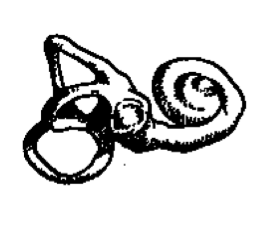The ear is a labyrinth. Imagine a sound getting lost in there, meeting up with itself after a series of wrong turns, doubling back to avoid a monster with an ax. What would such a sound… sound like? (In college my roommate listened to a group called Maze.)
Blame it on a wardrobe malfunction. Though I missed the infamous Super Bowl XXXVIII half-time show, I read about it the next day, over someone’s shoulder on the subway. The lyric “I’ll have you naked by the end of this song” seemed terrifying—not just the threat of Justin Timberlake peeling off the listener’s skivvies, but the regenerative nature of the threat within the duration of the music. The singer points to the limit of the artwork in question and says: You will be naked there. The world inside the song suddenly revealed itself as a nightmare of abandoned clothing and scary authorial confidence.
Now other terrors came to mind, musical Möbius strips. Some were chestnuts, others more recent favorites. Who doesn’t love the Beatles’ “I Will”? Yet now I was fixated on its endgame: “And when at last I find you / This song will fill the air.” Which song, Paul? This one? So then—if I’m hearing it right now—does that mean you’ve… found me? That you’re standing right behind me and—gaaaah! (Don’t do that!)
The moment of composition is no longer evident. The song does not exist as a discrete, safely reproducible aesthetic object. The present tense reasserts itself each time. It’s not the art that hides art, but the art that says look at me. It is what you might call postmodern.
How’s that? James Taylor, postmodernist? A plaintive line from that eternal classic, “Fire and Rain”—“I walked out this morning and I wrote down this song”—suddenly sounds dangerously unmoored. This morning; this song. When? Which? Help? “I just can’t remember who to send it to,” JT regrets.
Elton John did not have the same problem. “And you can tell everybody / This is your song,” he sings in “Your Song.” But can I? Would I want to boast about a song that explicitly acknowledges the fact that it’s mine—and the fact that I can tell everybody that it’s mine?
We fast-forward through the Me Decade (while acknowledging Carly Simon’s “You’re So Vain”: “You probably think this song is about you”—no, I don’t… though now that you mention it…) and land in the early ’80s on Billy Bragg’s “A New England”: “I was twenty-one years when I wrote this song / I’m twenty-two now but I won’t be for long.” Mr. Bragg—exactly how old were you when you wrote this song? Have you constantly been revising, tweaking it a little every year? How do I know I’m not going to press play and hear “I’m twenty-three now but I won’t be for long,” or, as the case may be, “forty-two and a half” or however old you are now?
The last line of Belle and Sebastian’s “Judy and the Dream of Horses” (itself the last song on their 1999 album If You’re Feeling Sinister) suddenly pulls back the screen, affording us a vertiginous view of its conception: “Write a song about your dream of horses / Call it ‘Judy and the Dream of Horses.’” What was once a lovely ditty now teeters on the edge of infinite regress.
The songs discussed all partake in what I will call the fear. The most head-on treatment of the fear might be Pulp’s wistful, magisterial “Something Changed,” which kicks off with this head-scratcher: “I wrote this song two hours before we met / I didn’t know your name or what you looked like yet.” Singer Jarvis Cocker, or his narrating stand-in, muses on predestination versus free will—wondering if a deity has mapped out his love affair beforehand, and so forth. The entire song is about the semimystical conditions of its creation: “Why did I write this song on that one day?”
As the love object in his story gently interjects, “Stop asking questions that don’t matter anyway.”





